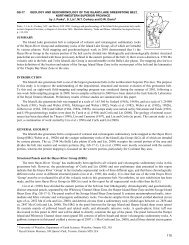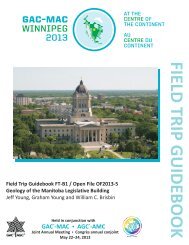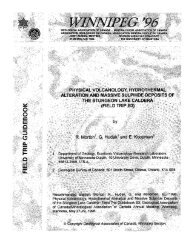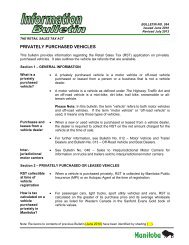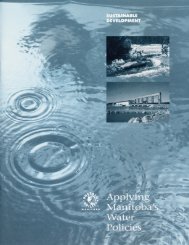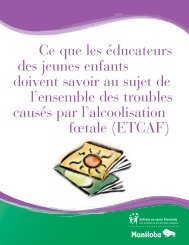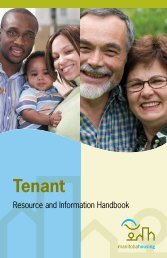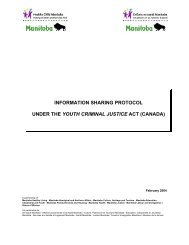Bridging to Adulthood - Government of Manitoba
Bridging to Adulthood - Government of Manitoba
Bridging to Adulthood - Government of Manitoba
- No tags were found...
Create successful ePaper yourself
Turn your PDF publications into a flip-book with our unique Google optimized e-Paper software.
Introductiono At fluence <strong>of</strong> 10 16 n eq /cm 2 , the limiting fac<strong>to</strong>rfor CCE is trapping <strong>of</strong> charges by radiationinduced trap levels:o Average Trapping time: τ tr = (5x10 -7 cm 2 /s × 10 16 n eq /cm 2 ) -1 =0.2 ns(H.W. Kraner et al, NIM A326 (1993) 350-356)o Charge collection distance: d cce =V dr τ tr ≤ V s × τ tr = 20 μm!o Q = 80d cce (1-exp(-t dr / τ tr )) electrons (d cce in μm ≤ d)o For planar detec<strong>to</strong>rs <strong>of</strong> d >100 μm inthickness, most volume is dead space even iffully depleted! Q ≈ 80d cce No dependence on d!o 3d detec<strong>to</strong>rs decouples the detec<strong>to</strong>rthickness (d) and depletion depth (W) (i.e. thepitch (P) <strong>of</strong> p and n electrodes)
Section OnePro<strong>to</strong>col for Transitioning Studentswith Exceptional Needsfrom School <strong>to</strong> Community7
THE TRANSITION PROTOCOL –Interactive Rolesand TimelinesThe transition pro<strong>to</strong>col identifi es who isresponsible for developing and implementingtransition plans for students with exceptionallearning needs when they require governmentsupports <strong>to</strong> enter the community. It outlinesthe tasks and their timelines.Partners in transition planning include:• the student and his/her support network(which may include: parents 1 and/orlegal guardians, siblings, friends,advocates, foster parents or group homestaff)• teachers and school/school divisionstaff/institutional school staff• community workers from Mani<strong>to</strong>baFamily Services and Housing programsincluding:- Children’s Special Services (CSS)- Employment and Income Assistance(EIA)- Vocational Rehabilitation (VR)program- Supported Living program (SLP)or designated agencies including CNIB,Society for Mani<strong>to</strong>bans with Disabilities(SMD), Canadian Paraplegic AssociationMani<strong>to</strong>ba Inc.(CPA)• community workers from regional healthauthority (RHA) programs in Mani<strong>to</strong>baincluding:- Community Mental Health (MH)services- Home Care program• community workers from applicablechild and family services (CFS) agenciesTransition planning should begin in theschool year in which the student enters highschool. The process concludes in June <strong>of</strong> thecalendar year in which the student turns 21or when he/she graduates. During this time,pr<strong>of</strong>essionals, the student, his/her supportnetwork and others work <strong>to</strong>gether <strong>to</strong> providethe student with a co-ordinated transitionfrom school <strong>to</strong> life in the community.The transition planning pro<strong>to</strong>col issummarized in Figure 1. The shaded rowsoutline key responsibilities <strong>of</strong> transitionpartners. The columns identify timelines forspecifi c tasks.See Appendix A for an interactive roles andtimeline checklist for case managers.1 In some cases only one parent or legal guardian may be involved in a child’s educational and transition planning.The term “parent” in this document can apply <strong>to</strong> any <strong>of</strong> these. The rights and responsibilities <strong>of</strong> parents may also apply<strong>to</strong> students once they have reached the age <strong>of</strong> majority. For information on The Vulnerable Persons Living with a MentalDisability Act, see Appendix H.9
Figure 1 - Interactive Roles and Time Lines In Transition PlanningINITIATING THE PROCESSHigh School Entry(Age 14 <strong>to</strong> 16) Age 16 <strong>to</strong> 17 AGE 17 <strong>to</strong> 18Students and/or parents/guardians with support networks, substitute decision maker(see Appendix H), teachers,• become aware <strong>of</strong> options & planning process• think about potential communityexperiences, graduation date, adult options• provide information on strengths/ interests/dreamsSchool• explore residential support services <strong>of</strong>personal preference or plan <strong>to</strong> reside infamily home• understand the implications <strong>of</strong> leaving schoolbefore completing graduation requirements,or availability <strong>of</strong> adult supports• at age 18 a person with disability may contactEmployment & Income Assistance forassessment <strong>of</strong> eligibility• apply for appropriate ID• age 18 may involve move <strong>to</strong> adult residentialfacility with support from adult programs(ex: SLP,MH)• appoint case manager for transition planning• co-ordinate initial planning meeting withthose closest <strong>to</strong> student (IEP team)• begin appropriate work/communityexperiences *• explore potential grad date and senior yearsprogramming direction with student, familyand IEP team• inform families about adult support options& transition planning process• contact adult program (SLP, MH, VR) whereno children’s worker involved or co-ordinatecontact with children’s worker• co-ordinate annual transition planningmeeting• research eligibility criteria for adult programs• initiate referrals <strong>to</strong> adult programs (SLP, VR,MH) in consultation with parents• include adult worker in IEP/ITP meetings• assist with gathering information regardingsupports required at home & in community• co-ordinate annual transition planningmeeting• increase focus <strong>of</strong> instruction <strong>to</strong>wards priorityoutcomes for transition• advocate for establishment <strong>of</strong> communitysupports for adult life, where none currentlyexist* May include ongoing career development, volunteer experiences, exploration <strong>of</strong> day programming options, exposure <strong>to</strong> recreational opportunities,transportation training, skills for living in the community with independence etc.Services for ChildrenChild and Family Service Agencies*• inform the family about the transitionplanning process and discuss potential adultservice options (EIA, VR, etc.) and eligibilityrequirements• complete referrals for appropriate adultservices in collaboration with the parents• attend school transitional planning meetings*Note: For children in care <strong>of</strong> child and familyservices agencies, CFS/legal guardian shouldbe involved in the process whenever a parentwould be involved• complete referrals for appropriate adultservices in collaboration with the family• link the appropriate adult service worker(s)<strong>to</strong> the family, upon confi rmation <strong>of</strong> programeligibility• participate in school transitional planningmeetings <strong>to</strong> ensure continuity <strong>of</strong> planning forservices and supports❑ continue <strong>to</strong> plan and make referrals <strong>to</strong>appropriate adult resourcesChildren’s Special Services,• inform the family about the transitionplanning process and discuss potential adultservice options (EIA, VR, etc.) and eligibilityrequirements• complete referrals for appropriate adultservices in collaboration with the parents• attend school transitional planning meetings• complete referrals for appropriate adultservices in collaboration with the family• link the appropriate adult service worker(s)<strong>to</strong> the family, upon confi rmation <strong>of</strong> programeligibility• participate in school transitional planningmeetings <strong>to</strong> ensure continuity <strong>of</strong> planning forservices and supportsIn consultation with adult worker• continue <strong>to</strong> plan and make referrals forrequired supportsChildren’s Mental Health• inform the family about the transitionplanning process and discuss potential adultservice options (EIA, VR etc.) and eligibilityrequirements• complete referrals for appropriate adultservices in collaboration with the parent/legalguardian• attend school transitional planning meetings• complete referrals for appropriate adultservices in collaboration with the family• link the appropriate adult service worker(s)<strong>to</strong> the family, upon confi rmation <strong>of</strong> programeligibility• participate in school transitional planningmeetings <strong>to</strong> ensure continuity <strong>of</strong> planning forservices and supportsIn consultation with adult worker• continue <strong>to</strong> plan and make referrals forrequired supports10
years where overlap may occurOne year Before GraduationGraduation Yearsiblings, relatives, friends, advocates, foster parents or group home staff• plan for post-secondary education/ training, work/communityplacement, or vocational/day service• choose supports that match individual preferences/needs or advocatefor new/enhanced services• make informed decisions about- employment- move <strong>to</strong> post-secondary education/training, work/communityopportunities- accessing a variety <strong>of</strong> supports/services from community basedservice providers.• co-ordinate annual transition planning meetings• increase work/community experiences*• ensure curriculum supports a planned move <strong>to</strong> post secondaryeducation/training• Ensure completion <strong>of</strong> SLP day services: information gathering andreferrals• include assigned adult community worker in planning meetings• identify resources required: work/community• co-ordinate annual transition planning meeting• include assigned VR community worker in planning meetings andprovide with current information• ensure graduation/completion requirements have been met• initiate long-term work/ community experience*• co-ordinate continuity <strong>of</strong> supports with adult community worker orwith work/community representative• a child and family services agency may continue involvement beyondage 18 for children who are permanent wards under the guardianship <strong>of</strong>the CFS agency, depending on individual circumstancescontinued on next page11
Figure 1 - Interactive Roles and Time Lines In Transition Planning (continued)INITIATING THE PROCESSHigh School Entry(Age 14 <strong>to</strong> 16) Age 16 <strong>to</strong> 17 AGE 17 <strong>to</strong> 18Services for Adults (Employment and Income Assistance, Supported Living Program, vocational rehabilitation services,• provide transition team with generalinformation re referral process, eligibilitycriteria, & adult service optionsHome Care Program• receive referral and conduct assessment <strong>to</strong>determine eligibility• provide information on adult resources• case co-ordina<strong>to</strong>r collaborates in developingcare plan• case co-ordina<strong>to</strong>r arranges services specifi edin care plan• participate in the facilitation <strong>of</strong> alternateresidential placement in communitySupported Living Program (SLP)• acknowledge receipt <strong>of</strong> referral, checkeligibility & assign community worker• community worker participates in planningmeetings with transition team (at least onebefore assuming case responsibility)• provide information on adult supports/service providers• request for funding for residential/supportservices if required at age 18• complete referrals <strong>to</strong> residential serviceprovider <strong>of</strong> choice as required• provide information for establishment <strong>of</strong>community supports for adult life, wherenone currently existDay Services• check eligibility & assign community worker• provide information on adult programs andresources in communityRegional Health Authorities (RHA)Mental Health (MH) Services and Supports• check eligibility and assign communityworker• assigned worker participates in planningmeetings (at least one before assuming caseresponsibility)• provide information on adult resources• complete referrals <strong>to</strong> adult resources• request for funding for residential and/orsupport services if required at age 18Home Care Program• assess and facilitate request for funding forresidential/support services if appropriate atage 1812
years where overlap may occurOne year Before GraduationGraduation Yearmental health services and supports, Home Care Program)Employment and Income Assistance• apply in person at age 18 and beyondVocational Rehabilitation Program FSH, RHA, designated agency (SMD, CNIB, CPA)• acknowledge receipt <strong>of</strong> referral, check eligibility & assign community worker• community worker participates in meetings with transition team• provide information on adult supports/ service providers• develop individual vocational plan• identify and initiate referral <strong>to</strong> service provider <strong>of</strong> choice and request funding for services, including technical assessments, upon studentleaving schoolSupported Living Program (SLP) – Day Services• ensure completion <strong>of</strong> previous steps in the referral process• community worker participates in meetings• request funding for day service resources two years before graduation date• referrals <strong>to</strong> day service resources and adult clinical services13
Interactive Roles and Responsibilities in Transition PlanningFig. 2Mani<strong>to</strong>baTransitionSupport SystemSchool Divisionsand Educa<strong>to</strong>rs• educationalprogramming• coordination<strong>of</strong> transitionplanningDesignated agencies andservice providersServices funded bygovernment and deliveredby designated agencies orservice providers.Mani<strong>to</strong>ba Transition SupportSystemTransition planning for students who willrequire government supports when theymove from school <strong>to</strong> life in the communityis necessary <strong>to</strong> ensure co-ordinated servicedelivery. The transition planning processdemands signifi cant collaboration betweenstudents, their family/support networks,school divisions, educa<strong>to</strong>rs and governmentand community service providers whoare responsible for implementing thetransition pro<strong>to</strong>col. To accomplish asuccessful transition, it is important thatall those involved with the students work<strong>to</strong>gether and fulfi ll their individual roles andresponsibilities.Figure 2 identifi es key supports that maybe involved with students in the transitionprocess.Mani<strong>to</strong>ba FamilyServices & Housing• Children’s SpecialServices• adult servicesStudentSupport Network• parents• friends• advocates• foster families• othersChild and familyservices authorities• CFS agenciesRegional HealthAuthorities• Mental healthservices for childrenand adults• Home Care programStudentsStudents are the central member <strong>of</strong> thetransition planning team. Their role iscritical in goal setting and decision making.Students and their support networks shouldbe active participants in transition planning.Support networks may include parents/legal guardians, siblings, relatives, friends,teachers, advocates, foster parents or grouphome staff.Students, with help from their supportnetworks, may participate in transitionplanning by:• attending IEP/ITP meetings• sharing information on his/her interests,skills and hopes for the future with theteam• becoming aware <strong>of</strong> options and theplanning process• participating in assessment designed <strong>to</strong>identify current skills and needs• expressing his/her opinions in thedecision making process• thinking about potential communityexperiences, graduation date, adul<strong>to</strong>ptions• choosing preferences for residentialsupport services or planning <strong>to</strong> reside intheir families home• understanding the implications <strong>of</strong>leaving school at age 16 or 17, orgraduation before adult supports areavailable• at age 18, contacting Employment andIncome Assistance for assessment <strong>of</strong>program eligibilityFor legislation affecting transitionteams, – see Appendix H.14
• at age 18, considering a move <strong>to</strong> anadult residential facility with supportfrom adult programs (ex: SupportedLiving Program)• planning for post secondary education/training, work/community placement, orvocational/day service• choosing supports that match individualpreferences/needs• working hard <strong>to</strong> complete schoolrequirementsParents, Legal Guardians, FosterParents, Caregivers and SupportNetworksParents, legal guardians, foster parents,caregivers and others legally authorized <strong>to</strong>make decisions are also key members <strong>of</strong>the transition team. They can ensure thattransition planning reflects the interests andvalues <strong>of</strong> the student.The school principal must ensure thatparents and students have the opportunity<strong>to</strong> have a person <strong>of</strong> their choosing in theprocess and attend planning meeting, etc.The suggested roles <strong>of</strong> these team membersinclude:• attending IEP/ITP meetings• sharing their knowledge students’interests, strengths and needs with theteam• supporting the students in the transitionprocess• participating in the decision makingprocess• encouraging and helping studentsparticipate in transition planning• fi nding information on availableservices and resources, currently or aftergraduation• supporting implementation <strong>of</strong> the plan• sharing information about students’progress• becoming familiar with The VulnerablePersons Act (see Appendix H)A Family Guide <strong>to</strong> the Vulnerable PersonsAct is available at:www.aclmb.ca/Guides/VPAfamily_Guide.pdf15
Interactive Roles and Responsibilities <strong>of</strong> Educa<strong>to</strong>rsAppropriate Educational Programming inMani<strong>to</strong>ba: Standards for Student Services(2006) reinforces the transition planningpro<strong>to</strong>col for students who will need adultsupports. Teachers’ roles are also outlinedin the Pupil File Guidelines (2004). They areavailable at:www.edu.gov.mb.ca/k12/specedu/aepwww.edu.gov.mb.ca/k12/docs/policy/mbpupil/index.htmlStudent Services Administra<strong>to</strong>rConsistent within Appropriate EducationalProgramming in Mani<strong>to</strong>ba, the studentservices administra<strong>to</strong>r or designate withina school division assumes a leading role intransition planning and is responsible for:• initiating contact early in the schoolyear (at the latest by November 30) withdesignated personnel from Mani<strong>to</strong>baFamily Services and Housing, regionalhealth authority programs and services,child and family services agenciesand others <strong>to</strong> discuss planning foridentifi ed students within the division• providing consultation and pr<strong>of</strong>essionallearning opportunities <strong>to</strong> equip thecase manager and the school staff fortransition planning for students withexceptional learning needsSchool PrincipalsPrincipals are responsible for students’Individual Education Plans and transitionplanning which includes:• initiating planning for students enteringhigh school who may require adultsupports and services when they leaveschool• identifying planning case managerswithin the school and ensuring planninginvolves teachers and other school staff• ensuring that transition planning isco-ordinated with students’ educationalprogramming• involving the registered nurse intransition for Unifi ed Referral and IntakeSystem (URIS) Group A students• ensuring the involvement <strong>of</strong> child andfamily services agencies, Mani<strong>to</strong>baFamily Services and Housing and/ordesignated agencies (CNIB, Societyfor Mani<strong>to</strong>bans with Disabilities andCanadian Paraplegic AssociationInc.) and/or regional health authorityprograms and services• ensuring planning is updated annually,or sooner if required• ensuring parents are meaningfullyinvolved in decision making• ensuring parents have the informationthey need <strong>to</strong> make informed decisions• ensuring students’ parents and studentshave the opportunity <strong>to</strong> have a person<strong>of</strong> their choosing at individual planningmeetings• establishing, maintaining and retaining apupil fi le for each student in a school• transferring the pupil fi le and pupilsupport fi le <strong>of</strong> students transferred <strong>to</strong>another school, within one week <strong>of</strong> thenew school requesting itDetermining when a student’s right <strong>to</strong> attend school ends:Students have the right <strong>to</strong> attend school until they graduate or until June <strong>of</strong> the calendar yearin which they turn 21. To determine when a student’s right <strong>to</strong> attend school ends, add 21 <strong>to</strong>their year <strong>of</strong> birth. For example:• Sharad’s birthday is Feb 15, 1990. He is eligible <strong>to</strong> attend school until June, 2011.• Courtney’s birthday is December 10, 1990. She is eligible <strong>to</strong> attend school until June, 2011.16
For information on the transfer <strong>of</strong> apupil file and continuation <strong>of</strong> transitionplanning when a student changesschools or school divisions, seeAppendix B.• ensuring appropriate referrals are made<strong>to</strong> the necessary adult support programsFor transition checklists –see Appendix CCase Managers(Transition Planning)Case managers are designated by principalsand they assume the major responsibilityfor co-ordinating the transition planningprocess. The educational activities <strong>of</strong> thestudent should be infused with transitionplanning. Principals should assign schoolstaff (ex: student services teacher, classroomteacher, counsellor,) who have responsibilityfor the educational programming <strong>of</strong> thestudent as the case manager, unless anotherpr<strong>of</strong>essional is more appropriate. Specifi croles <strong>of</strong> case managers in transition planninginclude:• scheduling and facilitating transitionplanning meetings• determining graduation dates alongwith students, parents or legal guardians• determining members <strong>of</strong> transitionplanning teams in consultation withstudents and parents• facilitating agreement about the rolesand responsibilities <strong>of</strong> members• moni<strong>to</strong>ring implementation <strong>of</strong> transitionplanning• maintaining transition planningdocuments (ex: student assessments,transition planning fi le, documentation<strong>of</strong> the plan, meeting notes and otherrelated materials)• updating plans annually and keepingpupil fi les current• maintaining communication with teammembers, students, parents or legalguardians• helping the student and parents fi ndservices and resources available in thecommunityTeachersStudents’ educational programmingshould be a part <strong>of</strong> the transition planningprocess. The commitment and collaboration<strong>of</strong> teachers (resource teachers, specialeducation teachers, classroom teachers,subject teachers, guidance counsellors) whoare involved with the students are critical.Teachers’ roles may include:• assessing the student’s strengths,needs, interests and performance• making connections between thetransition planning goals <strong>of</strong> the studentswith their educational goals• <strong>to</strong> help students who want postsecondary education identify therequirements and prepare accordinglySchool Division - StudentServices StaffStudent services staff who are closelyinvolved with transitioning students maybecome members <strong>of</strong> the transition planningteam. They may include speech and languagepathologists, occupational therapists, socialworkers, psychologists, etc. They may:• identify specifi c ongoing needs <strong>of</strong> thestudent including service requirements• provide assistance <strong>to</strong> increaseindependence and potential <strong>of</strong> thestudent <strong>to</strong> successfully adapt <strong>to</strong> andmaintain a more independent adult lifeFor information on AppropriateEducational Programming – high school– see Appendix D17
Interactive Roles and Responsibilities <strong>of</strong> Community Workersfrom: Mani<strong>to</strong>ba Family Services and Housing, Regional HealthPrograms/Services and Child and Family Services AgenciesChildren’s Services WorkersWorkers from Mani<strong>to</strong>ba Family Services andHousing, services provided by regional healthauthorities and child and family servicesagencies who are involved with the student,should participate in the transition planningprocess until the team agrees that a transfer<strong>to</strong> appropriate adult services is completed.Children’s Special ServicesMani<strong>to</strong>ba Family Services and Housing’sChildren’s Special Services (CSS) programprovides services and supports <strong>to</strong> birth,extended or adoptive families who areraising children with developmental and/orphysical disabilities. Services and supportsare available through regional <strong>of</strong>fi ces that arelocated throughout the province.The roles <strong>of</strong> the Children’s Special Services inthe transition planning process may include:• informing the family about the transitionplanning process and discussingpotential adult service options andeligibility requirements (EIA, VR, etc.)• completing referrals for appropriateadult services which include supportingdocumentation/current assessments incollaboration with the family and school• attending school transitional planningmeetings• connecting adult service worker(s) <strong>to</strong> thefamily when eligibility is confi rmed• participating in school transitionalplanning meetings <strong>to</strong> ensure continuity• working with adult service workers <strong>to</strong>provide ongoing planning and referralsChild and Adolescent CommunityMental Health WorkersThe roles <strong>of</strong> child and adolescentcommunity mental health workers, fromservices provided by regional healthauthorities may include:• attending transition planning meetings<strong>to</strong> provide current information <strong>to</strong> theteam on available services and supports• helping students, parents, school teamsand support networks explore anddetermine appropriate adult supportsand residential options• making referrals <strong>to</strong> appropriateprograms for adults withinrecommended time lines• connecting with assigned adult servicesworkers <strong>to</strong> co-ordinate supports andservices• helping students and families fi ndpotential resources in collaboration withadult services workers and school teamsChild and Family Services WorkersThe roles <strong>of</strong> the child and family servicesagency workers may include:• attending transition planning meetings<strong>to</strong> provide current information <strong>to</strong> teamsabout available services and supports• helping students, parents, school teamsand support networks fi nd appropriateadult supports and residential options• making referrals <strong>to</strong> appropriateprograms for adults withinrecommended time lines• connecting with assigned adult servicesworkers <strong>to</strong> co-ordinate supports andservices• helping students and families fi ndpotential resources in collaboration withadult services workers and school teams18
Adult Services WorkersAdult services workers from Mani<strong>to</strong>ba FamilyServices and Housing, designated agenciesand regional health authority programs/services must be involved in transitionplanning. One or more <strong>of</strong> the followingprograms may be considered, depending onthe needs <strong>of</strong> the student:• Employment and Income Assistance• Supported Living Program- Day Services- Residential• Vocational Rehabilitation Program(through Mani<strong>to</strong>ba Family Services andHousing; or designated agency, CNIB,Society for Mani<strong>to</strong>bans with Disabilities,Canadian Paraplegic Association Inc.)• Community Mental Health Services• Home Care ProgramSupport programs determine the student’seligibility for services. Once eligibility fora support program is determined and theavailability <strong>of</strong> the program is confi rmed, theroles <strong>of</strong> the adult worker may include:• providing information <strong>to</strong> students,parents and school teams on adultprograms and services (ex: residential,vocational and recreational) available inthe community• making referrals <strong>to</strong> appropriatecommunity adult programs and servicesand needed resources• ensuring wherever possible that adultservices are in place for students whenthey graduate• working with students, parents andschool teams in annual transitionplanning meetings as necessary (at leas<strong>to</strong>ne annual transition planning meetingbefore assuming case responsibility)Community Service ProvidersCommunity service providers includegovernment funded community organizationsthat may provide direct services for thoseeligible for adult supports. Communityservice providers may help transitionplanning teams by:• attending transition planning meetingsas required• presenting specifi c information <strong>to</strong> teamsabout their services• assisting the team in determining theknowledge and skills critical for thestudent <strong>to</strong> transition successfully <strong>to</strong>adult supports (suggestions for highpriority outcomes)• providing direction for students andplanning teams in preparing for,obtaining and maintaining employment(through assessment and assistance indeveloping work training outcomes andmethods)19
ADULT SUPPORT PROGRAMS AND SERVICESAdult Support Programs and Services Administeredby Mani<strong>to</strong>ba Family Services and Housing or Designated AgenciesAdult supports for individuals withexceptional needs may be provided byMani<strong>to</strong>ba Family Services and Housingthrough regional <strong>of</strong>fi ces or throughdesignated agencies including:• Employment and Income Assistance• Supported Living Program- Day Services- Residential• Vocational RehabilitationThese programs may include assessment,planning, information, referral, guidance,counselling, treatment, skill development andresource development.There are eligibility requirements foradult support services. Applicants mustbe Mani<strong>to</strong>ba residents who are Canadiancitizens or legally entitled <strong>to</strong> live and work inCanada. A registered member <strong>of</strong> an IndianBand in Mani<strong>to</strong>ba must have establisheda permanent residence <strong>of</strong>f-reserve before areferral or request for services.The Student, along with their transitionplanning teams should contact their regionalservice centres early in transition planningfor complete details on available programs,including eligibility requirements.Employment and IncomeAssistance (EIA) for Personswith DisabilitiesEmployment and Income Assistance isprovided through regional <strong>of</strong>fi ces <strong>of</strong> Mani<strong>to</strong>baFamily Services and Housing.Applicant must:• have a documented mental, learning, •physical, psychiatric or sensory disability• live in the community or in a long-termor chronic care facility• need fi nancial assistance <strong>to</strong> meet his/herneedsSupports AvailableEmployment and Income Assistance includesthe following services for eligible participants:• Income Assistance: provides funds orservices <strong>to</strong> help meet a person’s basicneeds, including a living allowance, anallowance for shelter (rent, room andboard, residential care charges) andessential health services. (Note thathealth services through EIA cover thecost <strong>of</strong> essential health needs, includingdrugs, dental services and opticalsupplies• Income Assistance for Persons withDisabilities: provides an additionalmonthly fi nancial benefi t <strong>to</strong> assist peoplewith disabilities with the additionalcost <strong>of</strong> living with a disability in thecommunity.• Work Incentive Program: allowsprogram participants <strong>to</strong> keep a portion<strong>of</strong> their earned income and still receivebenefi ts from the Employment andIncome Assistance Program. Under thisprogram, recipients will always havemore money if they work, than if they donot.Timelines for Referral and ServiceProvisionAn in-person application may be made atage 18.20
Supported Living Program (SLP)– Residential and Day ServicesServices are co-ordinated through communityservice workers <strong>to</strong> meet the unique needs <strong>of</strong>each individual. Supports and services areaccessed through regional <strong>of</strong>fi ces across theprovince as available.Applicants must:• have documented, signifi cantly impairedintellectual functioning accompaniedby impaired adaptive behaviour existingbefore reaching the age <strong>of</strong> 18• be a Canadian citizen or adult legallyentitled <strong>to</strong> permanently remain and workin Canada and a resident <strong>of</strong> Mani<strong>to</strong>baA. Residential ServicesResidential services include a range <strong>of</strong>supports <strong>to</strong> help individuals live in thecommunity. Options include:• independent living with supports –provides skill development and supportenabling adults <strong>to</strong> live on their own• family home – supports are providedso an individual can live with parents orextended family• residential care facilities – operated byan agency or private opera<strong>to</strong>r <strong>to</strong> provideaccommodation, care and supportconsistent with individual needsA self-directed program, In the Company<strong>of</strong> Friends, which links participantswith volunteer support networks in thecommunity, may also be available.B. Day ServicesDay services include a range <strong>of</strong> supports andtraining <strong>to</strong> help individuals participate in thecommunity through one or more activities:• supported employment and follow-upservices <strong>to</strong> support individuals in paidjobs in community settings• vocationally focused services <strong>to</strong>help develop, maintain and enhancevocational and social skills, provided in aday service facility or community setting• personal development services <strong>to</strong>develop, maintain and enhance anindividual’s personal care and socialskills, emotional growth, physicaldevelopment and community skillsAge for Service Availability:• residential services:at age 18• day services:July <strong>of</strong> the calendar year an individualturns 21Vocational RehabilitationVocational Rehabilitation services may bedelivered or co-ordinated by:1. Provincial <strong>Government</strong> -- Vocationalrehabilitation counsellors are locatedin the Mani<strong>to</strong>ba Family Services andHousing (FSH) regional <strong>of</strong>fi ces inrural and northern Mani<strong>to</strong>ba and incommunity area <strong>of</strong>fi ces in Winnipeg.FSH provides vocational rehabilitationservices <strong>to</strong> persons with mental, learningor psychiatric disabilities.2. Regional Health Authorities – Mentalhealth workers are located across theprovince thorough RHAs and provideservices <strong>to</strong> persons with psychiatricdisabilities. Some regions also employemployment development specialists.3. Designated Agencies – Some agenciesreceive provincial funding throughFSH <strong>to</strong> provide services <strong>to</strong> personswith specifi c disabilities. The threedesignated agencies are:a. Society for Mani<strong>to</strong>bans withDisabilities Inc. – provides vocationalservices <strong>to</strong> persons with a physicaldisabilities including the Deaf andhard <strong>of</strong> hearing (excluding personswith a visual disability or spinal cordinjuries).21
. Canadian Paraplegic Association– provides vocational services <strong>to</strong>persons with spinal cord injuries.c. CNIB – provides vocational services <strong>to</strong>persons with visual disabilities.Applicant must meet specifi c eligibilitycriteria and be able <strong>to</strong> enhance his/her ability<strong>to</strong> regularly pursue employment throughvoluntary participation in rehabilitation/training process appropriate for his or herindividual needs and vocational goals.Service OptionsThe Vocational Rehabilitation Programhelps participants develop an appropriatevocational plan based on their unique needs,interests and abilities. The implementation <strong>of</strong>the individual vocational rehabilitation planmay involve a single referral or a multi-yeartraining plan, including a variety <strong>of</strong> services,as follows:• School-<strong>to</strong>-Work Transition Program:provides funding <strong>to</strong> purchase supportsdesigned <strong>to</strong> facilitate the transition <strong>of</strong>eligible students from school <strong>to</strong> paidemployment.• Post-Secondary Education and Training:may provide funding support <strong>to</strong> assistindividuals <strong>to</strong> enrol in University orCommunity College programs.• Vocational Training: through a range <strong>of</strong>Assessment and Employment Servicesas well as training on the job.• Support Services: such as buildingor vehicle modifi cation, technicalaids or devices, special equipment,transportation, tu<strong>to</strong>rs, interpreters,sign language or note taking are alsomade available <strong>to</strong> assist or enablethe individual <strong>to</strong> pursue training oremployment goals.• Job Placement: assistance with resumepreparation, making contacts with jobplacement services, job referrals and jobdevelopment services.• Employment Support Services: are timelimited and may be funded <strong>to</strong> supportindividuals with work-related issuesimpacting on the ability <strong>to</strong> maintainemployment.Age for Service Availability:• Age 16 or over and not attending school.Inquiries for Employment and Income Assistance, Supported Living Programs, Vocational RehabilitationProgram, and other services from FSH:Contact information for FSH regional <strong>of</strong>fices is available at:www.gov.mb.ca/fs/locations/ruralnorthern.html(rural or northern regions <strong>of</strong> Mani<strong>to</strong>ba)or www.gov.mb.ca/fs/locations/winnipeg.html (Winnipeg).Inquiries for vocational rehabilitation services from the designated agencies should be directed <strong>to</strong>:Society for Mani<strong>to</strong>bans with Disabilities: www.smd.mb.ca/contact_us.aspxThe Canadian Paraplegic Association: www.cpamani<strong>to</strong>ba.ca/CNIB Vision Health Vision Hope www.cnib.ca/en/mb-sk/Default.aspx22
Adult Support Programs Funded by Mani<strong>to</strong>baHealth and Healthy LivingAdult support programs may be availablethrough regional health authorities (RHAs)and include the Community Mental HealthServices and Home Care ProgramRHAs deliver mental health services includingplanning, delivery and ongoing managemen<strong>to</strong>f services in Mani<strong>to</strong>ba. Community mentalhealth workers provide services throughthe RHAs and Community Mental HealthServices.Questions about the responsibilities atthe local level can be directed <strong>to</strong> theregional health authorities atwww.gov.mb.ca/health/rha/contact.htmlCommunity MentalHealth ServicesCommunity mental health providescomprehensive assessment, casemanagement, rehabilitation/treatment,counselling and crisis intervention,community consultation and education.Community mental health services staff helppeople with mental illness develop copingand living skills. They also help them fi ndother community services they may need.Eligibility for Community MentalHealth ServicesEach RHA has its own eligibility criteria andintake process. However, there are somecommon standards:• Services are for individuals with mentalhealth problems that compromisetheir capacity <strong>to</strong> participate in majorlife activities such as family life,employment, education, community orsocial relations (ex: schizophrenia, majoraffective disorders, bipolar disorders,anxiety disorders).• Participation is voluntary and requiresthe informed consent <strong>of</strong> the individualfor referral.• Services are usually for individuals 18years <strong>of</strong> age or older, who are residents<strong>of</strong> the regional health authority.RHAs can set their own eligibility criteriaand intake process. To fi nd out aboutspecifi c eligibility criteria applicants or theirdesignates must contact the RHA where thestudent resides.In addition <strong>to</strong> the services provided bycommunity mental health workers, RHAs mayhave a variety <strong>of</strong> additional programs. It isimportant <strong>to</strong> consult the home region <strong>of</strong> thestudent about the services available locally.Timelines for Referral and ServiceProvision• Referral: at age 17• Potential timeline for service <strong>to</strong> beavailable: at age 18 or olderHome Care ProgramThe regional health authorities deliver theHome Care Program including planning,delivery and ongoing management <strong>of</strong>services.The RHA’s are responsible for:• accepting referrals and determiningeligibility for home care services, basedon a multi-disciplinary assessment• developing a plan <strong>of</strong> care whichtakes in<strong>to</strong> account the needs <strong>of</strong> theindividual and family as well as availablecommunity resources• determining the amount and type <strong>of</strong>services <strong>to</strong> be provided23
Section TwoSupport Guidelines for Implementation<strong>of</strong> <strong>Bridging</strong> <strong>to</strong> <strong>Adulthood</strong>:A Pro<strong>to</strong>col for Transitioning Studentswith Exceptional Needs from School <strong>to</strong> Community25
Person-Centred Transition PlanningPerson-Centred PlanningStudents go through different stages <strong>of</strong>transition during their school years, frompreschool <strong>to</strong> school, from early years <strong>to</strong>middle years, from middle <strong>to</strong> senior yearsand from school <strong>to</strong> adult life. These stages<strong>of</strong>ten involve changes in environments, rolesand responsibilities, needs, and/or socialrelationships. The transition from school <strong>to</strong>adult life causes substantial changes in thelives <strong>of</strong> students and families.Person-centred planning strives <strong>to</strong> provideservices and supports that meet the specifi cneeds <strong>of</strong> the individual. To do this, theparticipation <strong>of</strong> the student is key and theirinterests, strengths and circumstancesare the foremost fac<strong>to</strong>rs <strong>to</strong> consider. Aperson-centred planning process willinvolve key people working <strong>to</strong>gether <strong>to</strong>develop a transition plan that meets thestudent’s needs, using available resources or,advocating for new or enhanced services.Person-centred transition planning mayinclude:• pursuing academic areas <strong>of</strong> interest andcontinuing meaningful involvement inschool life past age 18• celebrating the completion <strong>of</strong> highschool through the graduation ceremonywith peers, and then shifting focus<strong>to</strong>wards life/work preparation withcontinued support from the school• pursuing a combination <strong>of</strong> volunteer andwork experience through the school• shifting school focus <strong>to</strong>wardsmeaningful participation in communitylife (volunteerism, recreation)in increasing independence/interdependence• high school completion after fouryears and transition <strong>to</strong> the support <strong>of</strong> acommunity service provider• preparation for post secondaryeducation after high schoolPerson-Centred TransitionPlanningIndividual students’ strengths and needsare always unique and may require manyco-ordinated services for successfultransition. A student’s current level <strong>of</strong>performance in transition areas all becomea part <strong>of</strong> a student pr<strong>of</strong>i le that influenceshis/her transition planning. Considering astudent’s individual strengths and needshelps ensure a successful transition.Goals and ObjectivesThe goal <strong>of</strong> person-centred transitionplanning is <strong>to</strong> help students achieve anoptimum quality <strong>of</strong> life as they become adultsin the community. An effective team will:• identify the student’s interests,preferences, strengths and needs• involve and empower the student andfamily in the transition process• increase the capacity <strong>of</strong> the student formeaningful participation in communitylife• identify potential post school options(e.x: recreation, education and/orcommunity life)• identify and secure required resourcesand supports for successful transition• ensure that implementation plans aremade• involve the student, family and otherteam members in carrying out the plansEffective Practices inTransition PlanningThe following principles should be consideredin transition planning:1. early co-ordinated planning2. student, parent and support networkinvolvement3. team collaboration4. inclusive, community-based approaches27
5. developing a student’s selfdeterminationand self-advocacy skills6. comprehensive and functionalapproaches1. Early, Co-ordinated PlanningEarly planning gives teams suffi cient time<strong>to</strong> understand the student and their needs,develop his/her potential, secure necessaryresources and explore opportunities. To beeffective, transition planning should re-visitthe goals, activities, roles and responsibilities<strong>of</strong> team members, as the student grows older.2. Student, Family and SupportNetwork InvolvementStudent and family involvement (parents,siblings, grandparents) is fundamental <strong>to</strong>ensuring students’ needs, interests andcapabilities are reflected in the transitionplanning process.The student is the central member <strong>of</strong> thetransition planning team. His/her roleis particularly central in goal setting anddecision making. The roles <strong>of</strong> the student intransition planning include:• attending individual planning meetings,if possible• sharing information on his/her interests,skills and hopes for the future• participating in assessment designed <strong>to</strong>identify current skills and needs• identifying goals in transition planning• expressing his/her opinion in thedecision making process• fulfi lling his/her share <strong>of</strong> the responsibilities<strong>to</strong> reach the goals <strong>of</strong> the planParents are key members <strong>of</strong> the team whocan ensure that transition planning reflectsthe interests, benefi ts and values <strong>of</strong> thestudent. Suggested roles <strong>of</strong> parents include:• understanding the transition planningprocess and obtaining relevantinformation• attending IEP/ITP meetings• sharing their knowledge <strong>of</strong> their child’sinterests, strengths and needs• helping their child identify goalsachievable with effort• <strong>of</strong>fering opinions and participatingin the decision making process <strong>of</strong>transition planning• encouraging and helping their childparticipate in transition planning• fi nding information on services andresources available, currently or aftergraduation• helping their child carry out theresponsibilities assigned <strong>to</strong> him or her inthe transition plan• helping their child developindependence and self-determination ineveryday livingStrategies <strong>to</strong> support student involvement include:• previewing the agenda <strong>of</strong> team meetings with the student• providing the student with an orientation on the general process <strong>of</strong> transition planning• helping the student understand his/her role and responsibilities in transition planning and the signifi cance <strong>of</strong>his/her participation• using an alternate/augmentative communication system for the student if he/she has diffi culty communicating• ensuring suffi cient opportunities and time for the student <strong>to</strong> express opinions and make decisions• making transition planning meetings personal and welcoming <strong>to</strong> the student, by inviting individuals withwhom the student feels comfortable and arranging a welcoming environment (ex: preparing snacks, playingmusic, providing comfortable seating)28
Strategies for parental involvement• Clarify the roles and responsibilities <strong>of</strong> the parents in the process.• Maintain frequent communication with parents about the student’s needs and progress.• Provide orientation on the purpose, process and key decisions in transition planning (ex: web-basedinformation, booklets, information evenings).• Inform them about programs and services available in the community and how <strong>to</strong> access them (ex: transitionfairs, <strong>to</strong>urs <strong>of</strong> adult service providers, booklets).• Arrange transition planning meetings that are convenient for them <strong>to</strong> attend.• Provide them with a meeting agenda in advance.• Ensure they have opportunities <strong>to</strong> <strong>of</strong>fer their opinions freely and raise concerns during meetings.• visiting various placement optionsor programs <strong>to</strong> help their child makedecisions for future options (ex:residential, vocational, recreational)• sharing information about their child’sprogressAlong with the student and the family,members <strong>of</strong> the student’s support networkwho can provide valuable input for transitionplanning should be included in planning.A support network may include siblings,friends, advocates, foster parents, grouphome staff, etc.3. Team CollaborationTransition planning may involve manypartners from various disciplines andorganizations including school divisions,government, designated agencies, serviceproviders, advocates, Mani<strong>to</strong>ba Justice andthe community. It is critical <strong>to</strong> establish andmaintain a collaborative team <strong>to</strong> effectivelysupport the student through transition fromone support system <strong>to</strong> another.A collaborative approach allows teammembers <strong>to</strong> communicate and shareinformation and resources. Effective,accountable, seamless transition planningrelies on team collaboration. Clarifi cation <strong>of</strong>the roles and responsibilities <strong>of</strong> the membersis also crucial.4. Inclusive, Community-BasedApproachNo matter how intense and complex theneeds <strong>of</strong> a student are, everyone has the right<strong>to</strong> be included as part <strong>of</strong> the community asstudents and in<strong>to</strong> adult life. For studentswith exceptional needs, limited experiencesin the community and a lack <strong>of</strong> contact withpeers will be an indica<strong>to</strong>r <strong>of</strong> limited potentialfor inclusive community life. It is importantfor students <strong>to</strong> be a part <strong>of</strong> inclusivecommunities inside and outside <strong>of</strong> schoolso they can reach their goals in areas suchas social relationships and employment. Ininclusive schools, transition planning shouldfacilitate inclusive experiences and instructionfor a student with exceptional needs as muchas possible.5. Developing a Self-Determinationand Self-Advocacy SkillsDeveloping a student’s self-determinationand self-advocacy skills enhances theirown transition planning and the quality<strong>of</strong> their lives as adults in community life.This involves developing student specifi coutcomes in areas such as:• decision-making• problem solving• taking initiative• self-management29
The family, school and other team membersshould help students fi nd and useopportunities <strong>to</strong> develop and exercise selfdeterminationand self-advocacy in their dailyroutines. A student may require practice in:• expressing personal preferences andinterests• communicating wants and needs withothers• making decisions and explaining thereasons• identifying problems or diffi culties in agiven situation and fi nding solutions• being aware <strong>of</strong> situations that needself-advocacy (ex: discrimination,harassment, abuse, etc.), and how <strong>to</strong>deal with them• setting goals and taking action <strong>to</strong>achieve them6. A Comprehensive, FunctionalApproachTransition planning requires acomprehensive, functional approach coveringsuch things as vocational skills, social skills,independent living, health, daily living skillsand academic knowledge. For students withlimited daily living skills and diffi culties ingeneralizing learned skills, the transitionteam will need <strong>to</strong> focus on developingfunctional skills useful <strong>to</strong> adult life in thecommunity. Many students with exceptionalneeds require extensive, specifi c instructionsand/or support <strong>to</strong> develop many <strong>of</strong> the skillsothers acquire through daily experiences.In addition, teaching functional skills <strong>to</strong>students with exceptional needs may becombined with community-based experiences(ex: work experience, shopping/banking skills,transportation skills) in situations where theyare likely <strong>to</strong> be needed.Meeting PreparationWell organized meetings are essential foreffective person-centred transition planning.Case managers and other team membersshould ensure:• The individual student’s dreams andvision for future is the standard <strong>to</strong>wardwhich the planning team strives.• The planning should be results-orientedwith achievable goals and a plan forimplementing and moni<strong>to</strong>ring <strong>of</strong>outcomes.• The focus <strong>of</strong> the planning should be onthe strengths, interests and hopes <strong>of</strong>the student and the required supports,rather than on the student’s disabilities.• The planning should respect and reflectthe student’s background (ex: familyvalues, way <strong>of</strong> life, culture, communitylife).When, How Often and Where?Planning meetings may be formal or informal.Informal meetings can occur as frequently asneeded, anytime through the year and involvecontact by phone, e-mail or in person. Formaltransition planning meetings must be held atleast annually. Annual outcomes need <strong>to</strong> bedecided on soon after the beginning <strong>of</strong> eachschool year.The time and location for meetings should bearranged by case managers <strong>to</strong> accommodatethe participants as much as possible.Accessibility and convenience for thestudents and parents is important.Who should attend the meeting?A transition planning case manager shouldconsult with the student and parentsabout who will be invited <strong>to</strong> the IEP/ITPmeetings. The core team should include thestudent, parents and/or legal guardian/CFSagency worker and the case manager. Thestudent’s friends or advocates should alsobe welcomed <strong>to</strong> attend if their presence30
will provide support and/or importantinformation.While many pr<strong>of</strong>essionals and other supportpeople (ex: teachers, administra<strong>to</strong>rs,specialists, community service providers,advocates, etc.) may be involved in thetransition planning for the student, the teammay choose <strong>to</strong> invite only the people who aredirectly related <strong>to</strong> the issues on the agenda <strong>to</strong>any given meeting. The case manager shouldconsult with the student and family aboutwho they want <strong>to</strong> invite <strong>to</strong> a meeting.Conducting the MeetingPlanning meetings should look at prioritylearning needs holistically (e.g. employment,housing, personal management, health,community participation, recreation, etc.)<strong>to</strong> identify the needs <strong>of</strong> the student andco-ordinate services. The work <strong>of</strong> meetingparticipants may include:• sharing new information about thestudent• identifying gaps in what the team knowsabout a student• developing/updating a student pr<strong>of</strong>i le• evaluating the progress and outcomes <strong>of</strong>previous planning or describing currentlevels <strong>of</strong> performance• discussing adult support options andrequirements including contacts <strong>to</strong> bemade• setting the priorities <strong>to</strong> be addressed inthe plan• identifying student specifi c outcomesand performance objectives• developing implementation plans• establishing and updating roles andresponsibilities• identifying responsibilities for writing,updating and sharing IEPs or ITPsFor a checklist outlining steps for conductinga planning meeting, see Appendix F.Person-Centred Planning ToolsSome teams may choose <strong>to</strong> use specifi cperson-centred planning <strong>to</strong>ols for transitionplanning. Two <strong>to</strong>ols which are commonlyused are: Making Action Plans (MAPS) andPlanning Alternative Tomorrows with Hope(PATH).For further information on MAPS andPATH, see Appendix E.Strategies for team collaboration:• Create a positive, respectful and welcoming atmosphere.• Avoid the use <strong>of</strong> jargon.• Establish a joint vision and shared mission.• Ensure every member is familiar with the purpose <strong>of</strong> the transition planning process.• Clarify roles and responsibilities.• Develop specifi c implementation plans with assigned timelines and moni<strong>to</strong>r the process and results.• Establish a communication network among members (ex: phone, e-mail, regular meetings).• Develop agreements for collaborative teamwork and document them.The transition planning case manager’s leadershipis particularly crucial in ensuring team collaboration31
Transition Planning ProcessTransition planning may follow the sameprocess as individual education planning(IEP). In Mani<strong>to</strong>ba, IEP is a global term forany written plan developed by a team thataddresses the individual needs <strong>of</strong> a student.School teams, including families, are likely<strong>to</strong> be familiar with the IEP process. Whatmay occur, beginning in Grade 9, is that thestudent’s IEP planning process begins <strong>to</strong>take on a new perspective with domains andstudent specifi c outcomes (SSOs) addressingtransition needs taking priority as high schoolcompletion nears.Transition planning consists <strong>of</strong> four stepsconsistent with individual educationplanning:1. setting direction2. gathering information3. developing the transition plan4. implementing and reviewing the plan1. Setting DirectionCase managers who are responsible fortransition planning will identify key teammembers as the fi rst step <strong>of</strong> the process.The team members will include peoplewho are currently involved with the studentas members <strong>of</strong> the student’s IEP team.The team should also include people whowill be involved as the student prepares<strong>to</strong> leave school. These include communityworkers from Mani<strong>to</strong>ba Family Services andHousing, CNIB, Society for Mani<strong>to</strong>banswith Disabilities, the Canadian ParaplegicAssociation Inc., child and family servicesagencies and regional health authorityprograms/services. Community ServiceProviders and members <strong>of</strong> support networksmay also have a role in individual transitionplanning.Depending on the needs <strong>of</strong> the studentand individual circumstances, some teammembers will be permanent, while othersparticipate as needed basis or upon request.After identifying the team members, settingdirection may involve:• orienting the members about thetransition process• clarifying member’s roles andresponsibilities• deciding on a process for collaborationand sharing information2. Gathering InformationObservation and assessment are ongoingin transition planning. They help the teammoni<strong>to</strong>r the student’s transition needs anddetermine appropriate outcomes.The team may gather information about:• the student’s vision for the future as wellas interests, hopes and aptitude (withinput from family and support networkswhen appropriate)• background information about thestudent and his/her family andcommunity (ex: language, culture, way<strong>of</strong> life, etc.)• the student’s current level <strong>of</strong>performance, experiences, strengths andneeds• the skills or knowledge the studentrequires for successful transition• the available community based servicesand resources• the ongoing requirements foradaptations or assistive technologicaldevices or therapies <strong>to</strong> help the studentTo gather this information, the team may:• conduct curriculum-based assessments• collect work samples• interview the student, parents, teachers,or other support staff• use inven<strong>to</strong>ries or checklists from thestudent, parents, or other support staff32
• use specifi c observations <strong>of</strong> the studentin various settings (ex: classroom,home, worksites, retail s<strong>to</strong>re, etc.)• examine existing documents (ex: studentschool records, previous IEP or ITPassessments)• guide the student in developing a careerportfolio• assess the student’s specifi c skills invarious real life settings (ex: vocational,behavioural, academic)• conduct diagnostic assessments (formalor informal cognitive, or adaptivetesting)Student Self-Managed Career PortfolioGuide:Guidelines for students in Mani<strong>to</strong>ba<strong>to</strong> develop a career portfolio areavailable at:www.edu.gov.mb.ca/k12/cur/cardev/resources.html.3. Develop Individual PlansSelecting Priority Learning NeedsSuccessful adults try <strong>to</strong> balance their dailylives. Transition planning also requiresbalancing several areas:A. life-long lear ningB. employment/career d evelopmentC. building social networks and inclusionD. living in the community withindependenceAlthough priority outcomes in transitionplanning may vary for individual students,the team should assure that any concerns inthese areas are addressed.For information on developingannual student specific results, seeAppendix G.A. Life-long Learningi) Post Secondary EducationSome students may choose post secondaryeducation after high school. Persons withdisabilities have the right <strong>to</strong> reasonableaccommodation within post secondaryinstitutions. Post secondary institutionsmay require skills or specifi c prerequisitesfor acceptance that <strong>of</strong>ten demand long termpreparation, such as particular course creditsor skills. The transition planning team maysupport a student in areas such as:• exploring the student’s areas <strong>of</strong> interest,strengths and needs• supporting self-determination and selfadvocacyskills• helping the student develop skillsneeded for post secondary education(ex: effective study strategies, literacy,computer skills, communication)• learning what the entrance requirementsare for post secondary institutions• identifying disability services available inpost secondary institutions• helping the student in the applicationprocess• arranging for assistive technical devicesand investigate the portability <strong>of</strong>specialized equipment from one system<strong>of</strong> support <strong>to</strong> anotherFor information on post-secondaryeducation institutes in Mani<strong>to</strong>ba, seethe Advanced Education and Literacywebsite at: www.edu.gov.mb.ca/ael/unicoll/index.html.ii) Other Community Programs and TrainingOptionsStudents who do not choose post secondaryeducation may benefi t from other communityprograms or training opportunities <strong>to</strong>advance their employment or communitylife after graduation. The transition planningteam needs <strong>to</strong> assure that the student andthe family are able <strong>to</strong> access information onavailable community resources.33
For information on communityprograms and training for Mani<strong>to</strong>banswith exceptional needs, seewww.contactmb.org/.MB4Youth connects <strong>to</strong> services andprograms for young adults fromeducation <strong>to</strong> jobs, from driver licensingprograms, <strong>to</strong> environmental projects.www.edu.gov.mb.ca/mb4youthdivision/B. Employment/Career DevelopmentWork is the key means <strong>to</strong> achieve <strong>to</strong>independence, contribute <strong>to</strong> society, developsocial relationships and establish self-esteemfor many citizens. For this reason this area isparticularly important in transition planningfor students with exceptional needs. Somestudents may require specifi c individualsupports for career development. Throughcareer development a student may:• earn high school credits• learn and practise pre-vocational socialskills• develop employability skills• expand resumes and career portfolios• make contacts with people in thebusiness community• adjust employment expectations, exploreemployment options and narrow jobsearch focusC. Building Social Networks andInclusionThis area may involve developing friendships,collaborating with others and participatingin social and cultural events. Areas thetransition planning team may addressinclude:• developing social skills- <strong>of</strong>fering and asking for help- negotiating conflict• increasing social integration/networkingopportunities- maximizing inclusive placement withpeers and general public- exploring interests, hobbies, volunteerand leisure activities• meeting with those who interact with thestudent <strong>to</strong> help them- understand the characteristics,strengths and needs <strong>of</strong> the student- communicate comfortably andsuccessfully with the studentCareer Development CurriculumMani<strong>to</strong>ba’s career development curriculum are developed by Mani<strong>to</strong>ba Education Citizenship and Youth <strong>to</strong> helpschools prepare students for their future careers. The following fi ve themes included in Mani<strong>to</strong>ba’s life/workexploration curriculum are a guide for transition planning for all students, including those with exceptionalneeds:• personal management• career exploration• learning and planning• job seeking and job maintenance• career and community experiences34
D. Living in the Community withIndependenceThis area addresses the personalmanagement, community participation andself-advocacy issues that an independent adultfaces in the community. Examples include:• personal management- daily household tasks, such ascooking, cleaning, shopping- personal care, hygiene• community participation- voting- accessing community facilities,resources• self-advocacy- self-awareness (strengths, weakness,specifi c needs)- awareness <strong>of</strong> potential risks and abuseand ways <strong>to</strong> prevent or deal with themFor some students, increasing independencewill require specifi c training and supports. Tobe effective, the instruction and assistanceshould be combined with community-basedexperiences, in places where those skills aremostly likely <strong>to</strong> be used. Since many activitiesin the home environment involve theseindependent living skills, collaboration withhome is necessary in helping the studentdevelop and generalize necessary life skills.4. Plan Implementation and ReviewEffective implementation <strong>of</strong> the plan requiresongoing communication among the teammembers. Implementation also requires thatS.M.A.R.T. outcomes which include practical,effective instructional and assessmentstrategies are in place.SSO’s should be S.M.A.R.T.• Specifi c: written in clear, unambiguouslanguage• Measurable: allow student achievement<strong>to</strong> be described, assessed, and evaluated• Achievable: realistic for the student• Relevant: meaningful for the student• Time-related: can be accomplishedwithin a specifi ed time period, typicallyone school yearThe identifi ed learning outcomes andinstructional strategies are clearly unders<strong>to</strong>odby all team members involved on a daily basis.Implementing the plan also involves:• securing appropriate co-operation,partnerships, resources and services <strong>to</strong>implement the plan• maintaining ongoing communicationwith the student, parents, and otherteam members• moni<strong>to</strong>ring the progress <strong>of</strong>implementation• revising and adapting the plan asnecessary• communicating <strong>of</strong> the progress andoutcomes <strong>of</strong> the plan with teammembers• reviewing and updating the plan annuallyProblem Solving/Dispute ResolutionTransition planning involves a number <strong>of</strong>people working <strong>to</strong>gether for a commonpurpose. Different opinions are a natural par<strong>to</strong>f working relationships. Sometimes thesedifferences lead <strong>to</strong> disagreements or disputes.Informal dispute resolution is a co-operative,creative, problem solving process.Working Together: A Guide <strong>to</strong> PositiveProblem Solving for Schools, Families, andCommunities is a resource <strong>to</strong> support localschool and school division dispute resolutionpolicies and practices.Working Together: A Guide <strong>to</strong> PositiveProblem Solving for Schools, Families,and Communities can be found at:www.edu.gov.mb.ca/k12/specedu/problem_solving/index.html35
Appendices37
INITIATING THE PROCESSHigh School Entry(Age 14 <strong>to</strong> 16) Age 16 <strong>to</strong> 17 AGE 17 <strong>to</strong> 18Students and/or parents/guardians with support networks, substitute decision maker(see Appendix H), teachers,❑ become aware <strong>of</strong> options & planningprocess❑ think about potential communityexperiences, graduation date, adult options❑ provide information on strengths/ interests/dreamsSchool❑ appoint case manager for transitionplanning❑ co-ordinate initial planning meeting withthose closest <strong>to</strong> student (IEP team)❑ begin appropriate work/communityexperiences*❑ explore potential grad date and senior yearsprogramming direction with student, familyand IEP team❑ inform families about adult support options& transition planning process❑ contact adult program (SLP, MH, VR) whereno children’s worker involved or co-ordinatecontact with children’s worker❑ explore residential support services <strong>of</strong>personal preference or plan <strong>to</strong> reside infamily home❑ understand the implications <strong>of</strong> leavingschool before completing graduationrequirements, or availability <strong>of</strong> adultsupports❑ co-ordinate annual transition planningmeeting❑ research eligibility criteria for adultprograms❑ initiate referrals <strong>to</strong> adult programs (SLP,VR, MH) in consultation with parents❑ include adult worker in IEP/ITP meetings❑ assist with gathering information regardingsupports required at home and incommunity❑ at age 18 a person with disability maycontact Employment & Income Assistancefor assessment <strong>of</strong> eligibility❑ apply for appropriate ID❑ age 18 may involve move <strong>to</strong> adult residentialfacility with support from adult programs(ex: SLP,MH)❑ co-ordinate annual transition planningmeeting❑ increase focus <strong>of</strong> instruction <strong>to</strong>wards priorityoutcomes for transition❑ advocate for establishment <strong>of</strong> communitysupports for adult life, where none currentlyexist* May include ongoing career development, volunteer experiences, exploration <strong>of</strong> day programming options, exposure <strong>to</strong> recreational opportunities,transportation training, skills for living in the community with independence etc.Services for ChildrenChild and Family Service Agencies*❑ inform the family about the transitionplanning process and discuss potentialadult service options. (EIA, VR, etc.) andeligibility requirements❑ complete referrals for appropriate adultservices in collaboration with the parents.❑ attend school transitional planningmeetings.•Children’s Special Services,❑ inform the family about the transitionplanning process and discuss potentialadult service options. (EIA, VR, etc.) andeligibility requirements❑ complete referrals for appropriate adultservices in collaboration with the parents.❑ attend school transitional planningmeetingsChildren’s Mental Health❑ inform the family about the transitionplanning process and discuss potentialadult service options (EIA, VR, etc.) andeligibility requirements❑ complete referrals for appropriate adultservices in collaboration with the parent/legal guardian❑ attend school transitional planningmeetingsRegional contacts:❑ complete referrals for appropriate adultservices in collaboration with the family.❑ link the appropriate adult service worker(s)<strong>to</strong> the family, upon confi rmation <strong>of</strong> programeligibility❑ participate in school transitional planningmeetings <strong>to</strong> ensure continuity <strong>of</strong> planningfor services and supports❑ complete referrals for appropriate adultservices in collaboration with the family.❑ link the appropriate adult service worker(s)<strong>to</strong> the family, upon confi rmation <strong>of</strong> programeligibility❑ participate in school transitional planningmeetings <strong>to</strong> ensure continuity <strong>of</strong> planningfor services and supports❑ complete referrals for appropriate adultservices in collaboration with the family❑ link the appropriate adult service worker(s)<strong>to</strong> the family, upon confi rmation <strong>of</strong> programeligibility❑ participate in school transitional planningmeetings <strong>to</strong> ensure continuity <strong>of</strong> planningfor services and supports❑ continue <strong>to</strong> plan and make referrals <strong>to</strong>appropriate adult resourcesIn consultation with adult worker❑ continue <strong>to</strong> plan and make referrals forrequired supportsIn consultation with adult worker❑ continue <strong>to</strong> plan and make referrals forrequired supportsChildren’s Special Services (CSS) Phone # E-mail @(Other)_____________________ Phone # E-mail @38___________________________ Phone # E-mail @
APPENDIX Ayears where overlap may occurOne Year Before GraduationGraduation Yearsiblings, relatives, friends, advocates, foster parents or group home staff❑ plan for post-secondary education/ training, work/communityplacement, or vocational/day service❑ choose supports that match individual preferences/needs or new/enhanced servicesmake informed decisions about❑ employment❑ move <strong>to</strong> post-secondary education/training, work/communityopportunities❑ accessing a variety <strong>of</strong> supports/services from community basedservice providers.❑ co-ordinate annual transition planning meeting❑ increase work/community experiences❑ ensure curriculum supports a planned move <strong>to</strong> post secondaryeducation/training❑ ensure completion <strong>of</strong> SLP day services: information gathering andreferrals❑ include assigned adult community worker in planning meetings❑ identify resources required: work/community❑ co-ordinate annual transition planning meetings❑ increase work, community and /or recreation experiences❑ ensure curriculum supports move <strong>to</strong> post-secondary education/training❑ ensure completion <strong>of</strong> SLP Day Services: information gathering andreferrals❑ include assigned Adult Community Worker in planning meetings andprovide current information❑ identify resources required: work/community• a child and family services agency may continue involvement beyond age 18 for children who are permanent wards under the guardianship <strong>of</strong>the CFS agency, depending on individual circumstances39
INITIATING THE PROCESSHigh School Entry(Age 14 <strong>to</strong> 16) Age 16 <strong>to</strong> 17 AGE 17 <strong>to</strong> 18Services for Adults (Employment and Income Assistance, Supported Living Program, vocational rehabilitation services,❑ provide transition team with generalinformation re referral process, eligibilitycriteria, & adult service optionsHome Care Program❑ receive referral and conduct assessment <strong>to</strong>determine eligibility❑ provide information on adult resources❑ case co-ordina<strong>to</strong>r collaborates in developingcare plan❑ case co-ordina<strong>to</strong>r arranges services specifi edin care plan❑ participate in the facilitation <strong>of</strong> alternateresidential placement in communityRegional contactsRHA Contact Information:Name ___________________________ Phone #E-mailCommunity Mental HealthName ___________________________ Phone #@Supported Living Program (SLP)❑ acknowledge receipt <strong>of</strong> referral, checkeligibility & assign community worker❑ community worker participates in planningmeetings with transition team (at least onebefore assuming case responsibility)❑ provide information regarding adultsupports/ service providers❑ request for funding for residential/supportservices if required at age 18❑ complete referrals <strong>to</strong> residential serviceprovider <strong>of</strong> choice as required❑ provide information regarding theestablishment <strong>of</strong> community supports foradult life, where none currently existDay Services❑ check eligibility & assign community worker❑ provide information on adult programs andresources in communityRegional Health Authorities (RHA)Mental Health (MH) Services and Supports❑ check eligibility & assign community worker❑ assigned worker participates in planningmeetings (at least one before assuming caseresponsibility)❑ provide information re adult resources❑ complete referrals <strong>to</strong> adult resources❑ request for funding for residential and/orsupport services if required at age 18Home Care Program❑ assess and facilitate request for funding forresidential/support services if appropriate atage 18Regional Community Workers:NameE-mailPhoneAddressNameE-mailPhoneAddressE-mail@Supported Living ProgramName ___________________________ Phone #E-mail@Employment and Income AssistanceName ___________________________ Phone #E-mail@Vocational Rehabilitation ProgramName ___________________________ Phone #E-mail@OtherName ___________________________ Phone #E-mail@40
years where overlap may occurOne year Before GraduationGraduation Yearmental health services and supports, Home Care Program)Employment and Income Assistance❑ apply in person at age 18 and beyondRegional Offi ce Address: _____________________________________________Phone #___________________________________________________________Vocational Rehabilitation Program FSH, RHA, designated agency (SMD, CNIB, CPA)❑ acknowledge receipt <strong>of</strong> referral, check eligibility & assign community worker❑ community worker participates in meetings with transition team❑ provide information on adult supports/ service providers❑ develop individual vocational plan❑ identify and initiate referral <strong>to</strong> service provider <strong>of</strong> choice and request funding for services, including technical assessments, upon studentleaving schoolRegional Vocational Rehabilitation community workers:Name ___________________________ Phone # E-mail @Name ___________________________ Phone # E-mail @Name ___________________________ Phone # E-mail @Designated Agency Contacts:Name ___________________________ Phone # E-mail @Name ___________________________ Phone # E-mail @Name ___________________________ Phone # E-mail @Supported Living Program (SLP) – Day Services❑ ensure completion <strong>of</strong> previous steps in the referral process❑ community worker participates in meetings❑ request funding for day service resources two years before graduation❑ referrals <strong>to</strong> day service resources and adult clinical servicesName ___________________________ Phone # E-mail @Name ___________________________ Phone # E-mail @Name ___________________________ Phone # E-mail @41
APPENDIX BTransfer <strong>of</strong> a pupil file and continuation <strong>of</strong> transition planningwhen a student changes schools or school divisions.A pupil fi le and the pupil support fi le will contain information important for the transitionplanning team including a copy <strong>of</strong> the latest individual plan for the student. When a studenttransfers <strong>to</strong> another high school there is an expectation that transition planning will be carried onby the new team and the plan will be adjusted as necessary.A student’s pupil fi le and pupil support fi le will typically include:• information on the student’s citizenship and legal entitlement <strong>to</strong> work in Canada• the most recent individual education plan (IEP) and/or health care plan specifi cally devisedfor the student and any amendments• current notes on referrals <strong>to</strong>/contacts with external agencies (ex: child and family services)or caregivers• detailed documentation from school clinicians and special education/resource staff aboutall inter-agency contacts and services• ongoing health/psycho-social/counselling information, whether medical, psychological orbehavioural• the results <strong>of</strong> special diagnostic tests• reports from service providers such as agencies, hospitals and clinics• any other assessment or evaluations the parents/legal guardians or the student wantsplaced in the fi le42
Transition Case ChecklistsTransition Checklist - High School Entry - Age 14 <strong>to</strong> 16APPENDIX CName Phone #StudentParentLegal GuardianCase Manager (Transition)Children’s Program ContactCommunity WorkerSchoolDateInitiated Complete Not ApplicableIdentify case manager for transition planning.Provide general information <strong>to</strong> students, parents or legal guardianabout adult options and planning process.Co-ordinate initial planning with those closest <strong>to</strong> student (IEP team).Introduce community experiences.Explore potential graduation date and high school programmingdirection with students, parents or legal guardians and IEP team.Make initial contacts with adult programs (SLP, MH, VR, Home Care)if no children’s worker is involved or co-ordinate contact with children’sworker.Initiate referrals <strong>to</strong> SLP, VR and Home Care if appropriate.Student - With help from the Support NetworkDateInitiated Complete Not ApplicableBecome aware <strong>of</strong> options and planning process.Think about potential for❑ community experiences❑ graduation date❑ for adult options available❑ <strong>to</strong> share information on strengths/interests/dreams43
Transition Checklist - Age 16 <strong>to</strong> 17StudentParentLegal GuardianCase Manager (Transition)Children’s Program ContactCommunity WorkerSchoolDateInitiated Complete Not ApplicableName Phone #Student - With help from the Support NetworkDateInitiated Complete Not ApplicableIdentify case manager for transition planning.Co-ordinate annual transition planning meetings.Gather information on supports required at home and in community..Review eligibility criteria for adult programs.Include assigned adult community worker in planning meetings.Make initial contacts with adult programs (SLP, MH, VR, Home Care) if nochildren’s worker is involved or co-ordinate contact with children’s worker.Increase community (work and/or recreation) experiences.Ensure curriculum supports a planned move <strong>to</strong> post secondaryeducation/training.Identify resources required (work/community).Gather information and initiate referral <strong>to</strong> Supported Living Program.Initiate referrals <strong>to</strong> Community Mental Health if appropriate.Choose residential support services <strong>of</strong> personal preference or plan <strong>to</strong>reside in family home.Understand the implications <strong>of</strong> leaving school before completion <strong>of</strong>graduation requirements, or availability <strong>of</strong> adult supports.Plan for post-secondary education/ training, work/communityplacement or vocational/day services.Choose supports that match individual preferences/needs or advocatefor new/enhanced services.44
Transition Checklist - Age 17 <strong>to</strong> GraduationStudentParentLegal GuardianCase Manager (Transition)Children’s Program ContactCommunity WorkerSchoolDateInitiated Complete Not ApplicableName Phone #Student - With help from the Support NetworkDateInitiated Complete Not ApplicableIdentify case manager for transition planning.Co-ordinate annual transition planning meetings.Increase focus <strong>of</strong> instruction <strong>to</strong>wards priority outcomes for transition.Help determine appropriate community options for adult life.Include assigned community worker in planning meetings.Provide information on the student’s current performance and needs,including clinical (OT, PT SLP, Nutrition), <strong>to</strong> assigned communityworker.Ensure graduation requirements have been met.Initiate long-term work/ community experiences and investigatecontinuity post graduation in collaboration with community worker andsupport network.If student is 18 or older, contact Employment and Income Assistancefor persons with disabilities for assessment <strong>of</strong> eligibility.Make informed decisions about:❑ employment options❑ move <strong>to</strong> post secondary education/training, work/communityopportunities❑ accessing supports/services from community based serviceprovidersChoose adult community based supports or service provider fromavailable options.Apply for appropriate identifi cation.45
APPENDIX DAppropriate Educational ProgrammingStudents are eligible <strong>to</strong> attend school until they graduate or until June <strong>of</strong> the calendar year inwhich they turn 21, whichever comes fi rst. Appropriate educational programming is determinedby the school team in collaboration with the student and parents/legal guardians through theindividual education planning (IEP) process. The direction <strong>of</strong> programming is determined by thestudent’s pr<strong>of</strong>i le <strong>of</strong> need.This programming and planning is directed by The Public Schools Act, AppropriateEducational Programming in Mani<strong>to</strong>ba: Standards for Student Services, and severalsupporting documents and guidelines. They can be found at:www.edu.gov.mb.ca/k12/specedu/aep/index.html.Potential Programming Directions Include:AdaptationsAdaptation is the act <strong>of</strong> making changes in the teaching process, assessment process,instructional materials, or student products. These include, but are not limited <strong>to</strong>, changes <strong>to</strong> thephysical environment, social environment, presentations, tests and assessments, assignmentsand projects, organizational supports, time required <strong>to</strong> achieve provincial outcomes. Adaptationsare used when students with exceptional learning needs are able <strong>to</strong> meet the same learningoutcomes as their peers, through adaptations such as those listed above.Modification / Modified (M) Course DesignationStudents who have exceptional needs may benefi t from participating in the learningopportunities <strong>of</strong>fered in grades 9 <strong>to</strong> grade12 courses. If students have signifi cant cognitivedisabilities that do not allow them <strong>to</strong> meet the Mani<strong>to</strong>ba curriculum outcomes, even withsupports, the school team determines that these students’ courses will be modifi ed and theywill receive a Modifi ed (M) course designation. It is important that students and parentsare included in this decision. The (M) course designation is applied on an individual coursebasis <strong>to</strong> those courses developed or approved by Mani<strong>to</strong>ba Education Citizenship and Youth.Modifi cation means that the number or content <strong>of</strong> the Mani<strong>to</strong>ba curriculum outcomes arechanged <strong>to</strong> meet a student’s cognitive learning needs. Modifi cations need <strong>to</strong> be outlined inan IEP and identifi ed on a student’s report card. Students in Grade 9 <strong>to</strong> Grade 12 receive apercentage mark according <strong>to</strong> their achievement <strong>of</strong> the modifi ed curriculum.For more information, see <strong>to</strong> Towards Inclusion: A Handbook for Modified CourseDesignation, Senior 1-4 at: www.edu.gov.mb.ca/k12/sepcedu/modified/index.html.46
Individualized Programming/Individualized Programming DesignationSome students’ cognitive disabilities are so severe that they require learning outcomes that are individualized anddifferent than the Mani<strong>to</strong>ba curricular outcomes. These students need appropriate educational programming basedon highly individualized and, functional student-specifi c outcomes within age-appropriate school and communityenvironments. A team that includes parents makes the decision <strong>to</strong> provide individualized programming based on thestudent’s cognitive ability. The student’s specifi c outcomes or goals should be outlined in an IEP. Students receivingan individualized programming designation in high school do not use Mani<strong>to</strong>ba Education, Citizenship and Youthcurriculum. Individualized programming <strong>of</strong>ten includes vocational and transition planning for life after school.The Individualized (I) programming designation is not course specifi c but identifi es a full year <strong>of</strong> individualizedprogramming. Students do not receive marks; their progress is documented through the IEP process.Note: students can participate in the modifi ed course designations (M) or individualized designations (I), but notboth.For additional information on individualized programming, see Towards Inclusion: A Handbook for Individualized(I) Programming Designation, Senior Years at: www.edu.gov.mb.ca/k12/specedu/individu/index.html.High School GraduationOpportunities are available for students (including those with signifi cant cognitive disabilities) <strong>to</strong> choose coursesthat are <strong>of</strong> interest <strong>to</strong> them. High school students earn credits for compulsory and optional courses, locally developedcourses, distance education courses, post secondary courses (college and university) and others such as communityservice. Students who have completed the required number <strong>of</strong> compulsory and optional courses, including (M) coursedesignations, receive a Mani<strong>to</strong>ba high school diploma.For more information on graduation requirements in Mani<strong>to</strong>ba see:www.edu.gov.mb.ca/k12/policy/grad_require.html.Certificate <strong>of</strong> Completion for Students Receiving Individualized Programming DesignationIn March 2007, Mani<strong>to</strong>ba Education, Citizenship and Youth introduced a certificate <strong>of</strong> completion for anIndividualized Senior Years program, effective in the 2006 <strong>to</strong> 2007 school year. This certificate recognizesthe achievement <strong>of</strong> students with significant cognitive disabilities who benefit from a highly individualized,functionally appropriate learning experience.Information guidelines for awarding the certificate are available atwww.edu.gov.mb.ca/k12/policy/grad_require.html.Certificates <strong>of</strong> completion can be ordered through the Mani<strong>to</strong>ba Text Book Bureau at www.mtbb.mb.ca/,s<strong>to</strong>ck #72501.47
APPENDIX EPerson-Centred Planning ToolsMaking Action Plans (MAPS)MAPS was developed by Marsha Forest and is based on 24-Hour planning by Karen GreenMcGowan. The framework <strong>of</strong> MAPS:1. What is the his<strong>to</strong>ry <strong>of</strong> the student? The student and the family are given opportunities <strong>to</strong> tellthe team what the student’s life has been like.2. What are the dreams <strong>of</strong> the student? The student (and his/her support network, if necessary)is asked <strong>to</strong> describe the dreams or visions <strong>of</strong> the student.3. What are the potential nightmares or overriding issues? The team brains<strong>to</strong>rm on what willhappen if they do not work <strong>to</strong>gether <strong>to</strong> make change or leave things as they are?4. Who is the student? The student and the team establish a detailed understanding <strong>of</strong> theindividual.5. What are the student’s strengths, gifts, and talents?6. What are the student’s needs?7. What is the plan <strong>of</strong> action? What are the goals, steps or supports required <strong>to</strong> achieve thegoals?Planning Alternative Tomorrows with Hope (PATH)PATH was developed by John O’Brien, Marsha Forest and Jack Pierpoint <strong>of</strong> Inclusion Press.The PATH process involves the following:1. Identifying dreams and values <strong>of</strong> the student2. Setting positive and achievable goals, based on the identifi ed dreams <strong>of</strong> the student3. Identifying the current capacity <strong>of</strong> the student, the resources available and the gap betweenpresent needs and desirable goals4. Identifying people <strong>to</strong> enroll who can help achieve the goals5. Recognizing ways <strong>to</strong> build strength through services or resources6. Charting action for the next few months7. Planning the next month’s action8. Committing <strong>to</strong> the fi rst stepFor Further information visit:Inclusion Press at www.inclusion.com48
Conducting a Planning MeetingAPPENDIX FBefore the meeting:❑ send an agenda <strong>to</strong> the potential participants❑ indicate time and place <strong>of</strong> meeting❑ assign a meeting facilita<strong>to</strong>r (may or may not be the case manager)❑ preview the agenda, process, and expected attendants <strong>of</strong> the meeting with the student andparents and discuss concerns or issues that they would like <strong>to</strong> raiseDuring the meeting:❑ introduce everyone present, when necessary, and their roles❑ state the purpose <strong>of</strong> the meeting and its expected time limits❑ review the agenda and make changes as required❑ assign a recorder❑ focus on person-centred and outcome-oriented planning❑ move through and discuss the agenda items❑ discuss implementation plans and clarify members’ responsibilities, timeline, achievementcriteria for each plan❑ summarize the discussion and decisions <strong>of</strong> the meeting❑ set time and location for the next meetingFollow-up <strong>of</strong> the meeting:❑ distribute the minute <strong>of</strong> the previous meeting and the agenda for the next meeting❑ discuss the minutes <strong>of</strong> the meeting with the student and/or parent, if necessary❑ maintain contact with team members for problem-solving and follow-up on progress <strong>of</strong>performance objectives and student specifi c outcomesAdapted from: Individual Education Planning: A Handbook for Developing and ImplementingIEPs Early <strong>to</strong> Senior Years, Mani<strong>to</strong>ba Education Training and Youth, 199849
APPENDIX GAnnual Student Specific Outcomes:A manageable plan will summarize only the team’s highest priorities for the school year withincategories called domains. Student Specifi c Outcomes (SSOs) may be developed <strong>to</strong> addressspecifi c areas in each domain:• While the plan will not outline all the teaching and learning experiences <strong>of</strong> the studentduring the school year, it will describe the highest priority outcomes that the team willmeasure and expect the student <strong>to</strong> achieve during the school yearStudent Specifi c Outcomes may stem from priority learning needs such as life-long educationand training, employment/career development, building social relationships and networks and/or living with independence in the communitySSOs should:• Be derived from the student’s current level <strong>of</strong> performance.• Take in<strong>to</strong> consideration the students past achievement and rate <strong>of</strong> progress.• Challenge the student but be achievable.• Be relevant <strong>to</strong> the student’s needs.• Focus on what the student will do, rather that what he or she will s<strong>to</strong>p doing.• Be achievable with respect <strong>to</strong> the instructional time and resources available.SSO’s should be S.M.A.R.T.• Specifi c: written in clear, unambiguous language• Measurable: allow student achievement <strong>to</strong> be described, assessed, and evaluated• Achievable: realistic for the student• Relevant: meaningful for the student• Time-related: can be accomplished within a specifi ed time period, typically one school yearIn addition, the outcomes should specify the conditions (ex: assistive technology device,environment and level <strong>of</strong> assistance) and the criteria (ex: frequency and degree <strong>of</strong> completion)under which they are <strong>to</strong> be achieved.50
Legislation Affecting Transition Planning TeamsAPPENDIX HThe Mani<strong>to</strong>ba Human Rights CodeThe Mani<strong>to</strong>ba Human Rights Code prohibits unreasonable discrimination arising from aperson’s actual or perceived physical or mental disability.For more information visit: www.gov.mb.ca/hrc/english/publications/factsheets/p-disab.html.Vulnerable Persons Living with Mental Disability ActThe act reflects the right <strong>of</strong> all people <strong>to</strong> make their own decisions and <strong>to</strong> have help whennecessary in a manner that respects their independence, privacy and dignity. Substitute decisionmaking is described in this act.For more information visit: www.gov.mb.ca/fs/pwd/vpact.html.The Healthy Child Mani<strong>to</strong>ba ActThe purpose <strong>of</strong> this act is <strong>to</strong> guide the development, implementation and evaluation <strong>of</strong> theHealthy Child Mani<strong>to</strong>ba strategy in the government and in Mani<strong>to</strong>ba communities generally. Theact continues the Healthy Child Committee <strong>of</strong> Cabinet, unique in Canada, ensuring the on-goingleadership <strong>of</strong> all ministers whose portfolios or departments directly affect the lives <strong>of</strong> children.For more information visit: web2.gov.mb.ca/laws/statutes/ccsm/h037e.php.The Protection for Persons in Care ActThe act helps protect adults from abuse while receiving care in personal care homes, hospitals orany other designated health facility.For more information visit: www.gov.mb.ca/health/protection/.Appropriate Educational Programming in Mani<strong>to</strong>ba:Standards for Student ServicesAppropriate Educational Programming in Mani<strong>to</strong>ba: Standards for Student Services embodiesthe spirit <strong>of</strong> human rights legislation and regulations, elaborates on the education regulationsand establishes standards for school divisions. The standards provide school divisions with aframework <strong>to</strong> use in developing a local policy for appropriate educational programming.For more information visit: www.edu.gov.mb.ca/k12/specedu/aep/index.html.The Child and Family Services ActThe Child and Family Services Act outlines the fundamental principles guiding the provision <strong>of</strong>services <strong>to</strong> children and families in Mani<strong>to</strong>ba.For more information visit: web2.gov.mb.ca/laws/statutes/ccsm/c080e.php.The Child and Family Services Authorities ActThe purpose <strong>of</strong> the Child and Family Services Authorities Act is <strong>to</strong> establish authorities thatare responsible for administering and providing for the delivery <strong>of</strong> child and family services inMani<strong>to</strong>ba. For more information visit: web2.gov.mb.ca/laws/statutes/2002/c03502e.php.51
The Personal Health Information ActThe purpose <strong>of</strong> the Personal Health Information Act (PHIA) and the related Freedom <strong>of</strong>Information and Protection <strong>of</strong> Privacy Act (FIPPA) is <strong>to</strong> provide individuals with a right <strong>to</strong>examine and receive a copy <strong>of</strong> personal health information about themselves, <strong>to</strong> control themanner in which personal health information is collected and the right <strong>to</strong> request corrections<strong>to</strong> personal health information about themselves. This act also protects individuals against theunauthorized use <strong>of</strong> personal health information.For more information visit: www.gov.mb.ca/health/phia/links.html.The Youth Criminal Justice Act (Canada)The Youth Criminal Justice Act (YCJA) deals with records and information <strong>of</strong> youth whohave been dealt with under the act. Statutes such as the Public Schools Act, the EducationalAdministration Act, FIPPA and PHIA do not apply <strong>to</strong> youth criminal justice information. TheYCJA permits limited disclosure <strong>of</strong> information in records kept under this act and youth criminaljustice information must be handled in accordance with the YCJA even when it is included aspart <strong>of</strong> a pupil fi le or some other record.For more information visit: www.justice.gc.ca52



